rotten > Library > Culture > Doctor Who
Doctor Who
exterminate exterminate exterminate
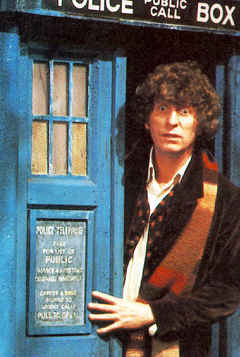 Star Trek has a reputation for attracting a certain class of obsessive, socially stunted fan. But when the latest Trek fan film isn't geeky enough to fully satisfy the escapist yen of your Linux-loving, Zaurus-toting, polyester-wearing ass, there is only one fully pedigreed alternative suitable for your viewing needs—the one and only Doctor Who.
Star Trek has a reputation for attracting a certain class of obsessive, socially stunted fan. But when the latest Trek fan film isn't geeky enough to fully satisfy the escapist yen of your Linux-loving, Zaurus-toting, polyester-wearing ass, there is only one fully pedigreed alternative suitable for your viewing needs—the one and only Doctor Who.
(Unless you're British, in which case loving Doctor Who comes as naturally as loving Seinfeld does to Americans.)
The original Doctor Who was a serialized children's show on the BBC, based on a high concept that boils down to "Willy Wonka meets H.G. Wells." In the early episodes, The Doctor was a cantankerous grandfather who inexplicably owned a time machine.
The first season of Doctor Who was long on action and short on explanations, but you don't stay on the air continuously for 26 years—for around 700 episodes—without providing some backstory. Over time, the following basic mythos emerged from the Doctor's endless hours on television (notwithstanding numerous continuity glitches):
- The Doctor is an alien known as a Time Lord from the planet Gallifrey.
- Purists will tell you that his name is "The Doctor," not "Doctor Who," despite the fact that he was listed as "Doctor Who" in the credits for years and occasionally referred to by that name on screen.
- The Time Lords basically spend their lives sitting around watching time happen, but they don't interfere in the events of history.
- The Doctor is not a very good Time Lord, because he rather enjoys interfering in events. Much hilarity ensues.
- The Doctor careens through time interfering in said events with no apparent rhyme or reason. For company, he brings along random beings encountered during his travels.
- Although his companions frequently include voluptuous women in glittery lycra, the Doctor never gets romantically or physically involved with his companions.
- The TARDIS is the Doctor's time machine, which looks like a police call box (basically a phone booth) from the outside, but contains acres of extradimensional space on the inside, consisting primarily of gleaming control panels.
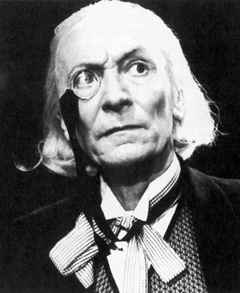 Over the course of Doctor Who history, there have been 10 different doctors (not counting a few casting flukes too geeky to get into here). Producers came up with the idea that The Doctor's body is periodically replaced by a new version when actor who played the original Doctor fell ill and had to be replaced.
Over the course of Doctor Who history, there have been 10 different doctors (not counting a few casting flukes too geeky to get into here). Producers came up with the idea that The Doctor's body is periodically replaced by a new version when actor who played the original Doctor fell ill and had to be replaced.
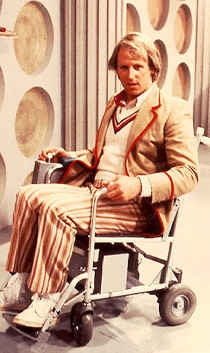 The show debuted in 1963 to adequate ratings, but Doctor Who didn't gather steam until veteran TV screenwriter Terry Nation created the series' most memorable element—the Daleks, killer cyborgs with a bad attitude, who unfortunately resembled trash cans mounted with light bulbs, bugles, and buzzing dildoid wands (think R2D2 meets The Terminator). As if their appearance weren't ridiculous enough, the Daleks rolled (and occasionally floated) around proclaiming their basic credo in a faux robotic monotone. The credo consisted of three words: EXTERMINATE. EXTERMINATE. EXTERMINATE.
The show debuted in 1963 to adequate ratings, but Doctor Who didn't gather steam until veteran TV screenwriter Terry Nation created the series' most memorable element—the Daleks, killer cyborgs with a bad attitude, who unfortunately resembled trash cans mounted with light bulbs, bugles, and buzzing dildoid wands (think R2D2 meets The Terminator). As if their appearance weren't ridiculous enough, the Daleks rolled (and occasionally floated) around proclaiming their basic credo in a faux robotic monotone. The credo consisted of three words: EXTERMINATE. EXTERMINATE. EXTERMINATE.
Science fiction consumers in the mid-1960s had been conditioned to accept the likes of It Came From Outer Space and Them, so the Daleks fit right in. Or maybe it's a British thing—the Daleks were voted the most evil villains in television history in a British survey as recently as 2003.
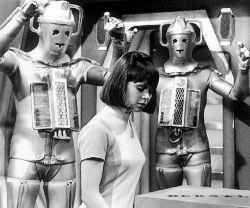 Whatever the source of its strange appeal, Doctor Who proved as undeniable and inexhaustible as the Daleks themselves. Building on the success of the Daleks, the writers crafted many imaginative alien opponents for the intrepid Doctor, such as the Robomen (humanoid Daleks!), the Cybermen (not Daleks, but like Daleks, only humanoid!), the Autons (like Daleks, but humanoid and plastic!) and the Yeti (like Daleks, but humanoid and furry!).
Whatever the source of its strange appeal, Doctor Who proved as undeniable and inexhaustible as the Daleks themselves. Building on the success of the Daleks, the writers crafted many imaginative alien opponents for the intrepid Doctor, such as the Robomen (humanoid Daleks!), the Cybermen (not Daleks, but like Daleks, only humanoid!), the Autons (like Daleks, but humanoid and plastic!) and the Yeti (like Daleks, but humanoid and furry!).
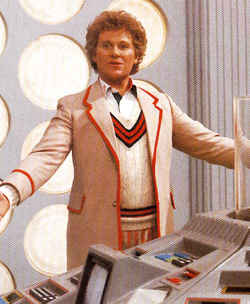 The debut of the bloodthirsty Daleks also shaped the direction of the series. Originally conceived as an educational adventure (along the lines of the later Where in the World is Carmen Sandiego?), Doctor Who quickly became the televised equivalent of the 1950s Hollywood sci-fi genre—including the cheesy dialogue, asexual characters, gobbledygook science and excruciatingly bad special effects.
The debut of the bloodthirsty Daleks also shaped the direction of the series. Originally conceived as an educational adventure (along the lines of the later Where in the World is Carmen Sandiego?), Doctor Who quickly became the televised equivalent of the 1950s Hollywood sci-fi genre—including the cheesy dialogue, asexual characters, gobbledygook science and excruciatingly bad special effects.
In other words, the show was frequently terrifying to children but strictly camp for adults, with a fine sense of its own absurdity (some episodes were openly comedic, including a handful written by Douglas Adams, creator of The Hitchhiker's Guide to the Galaxy).
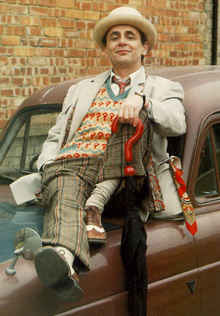 Viewership soared into the millions and the show became a mainstay of BBC television for more than two decades. Although it was a mainstream phenom in the U.K., Doctor Who was more of a cult hit in the U.S., airing on public television and attracting a demographic of kids too geeky to be satisfied with Star Trek.
Viewership soared into the millions and the show became a mainstay of BBC television for more than two decades. Although it was a mainstream phenom in the U.K., Doctor Who was more of a cult hit in the U.S., airing on public television and attracting a demographic of kids too geeky to be satisfied with Star Trek.
From 1963 through 1989, Doctor Who was a constant presence on the British cultural scene. The series exploded into virtually every medium, including books, magazines, trading cards, comic books, soundtracks and songs "inspired by" the Doctor Who theme, numerous televised specials and even two feature films starring Peter Cushing in the title role.
 Doctor Who also became an almost unparalleled force in the world of merchandising, with a breadth of offerings comparable to Hello Kitty. An unbelievable flood of Doctor Who memorabilia chokes the bandwidth of eBay to this day, including inflatable dolls, bottle stoppers, t-shirts, keychains, coffee mugs, cell phone faceplates, paperweights, coasters, cookie jars, remote-control Daleks, collectable plates and replicas of the Doctor's all-purpose technological gizmo, the sonic screwdriver.
Doctor Who also became an almost unparalleled force in the world of merchandising, with a breadth of offerings comparable to Hello Kitty. An unbelievable flood of Doctor Who memorabilia chokes the bandwidth of eBay to this day, including inflatable dolls, bottle stoppers, t-shirts, keychains, coffee mugs, cell phone faceplates, paperweights, coasters, cookie jars, remote-control Daleks, collectable plates and replicas of the Doctor's all-purpose technological gizmo, the sonic screwdriver.
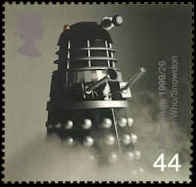 The Daleks have managed to accomplish even more than the Doctor, with an official Dalek stamp issued by the British government in 1999. One of the Doctor's television assistants, Katy Manning, even posed for an infamous "Dalek porn" shoot after leaving the show, much to the glee of Doctor Who's undersexed American fan base.
The Daleks have managed to accomplish even more than the Doctor, with an official Dalek stamp issued by the British government in 1999. One of the Doctor's television assistants, Katy Manning, even posed for an infamous "Dalek porn" shoot after leaving the show, much to the glee of Doctor Who's undersexed American fan base.
As Doctor Who cruised into its third decade of nearly continuous episodes, the appeal of the Doctor and his adventures began to wear thin. Ratings declined as viewers started turning the dial in search of new entertainment, and the situation was aggravated by backstage politics at the BBC and on the set.
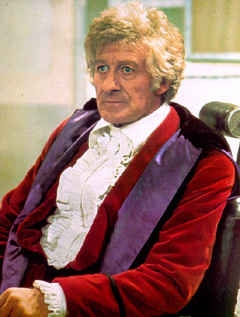 In 1989, after 23 years on the air, Doctor Who finally vanished from the British airwaves, effectively canceled although it was never formally characterized as such. Doctor Who continued to resurface fitfully through the 1990s in a series of specials, semi-parodies and an American-made TV movie.
In 1989, after 23 years on the air, Doctor Who finally vanished from the British airwaves, effectively canceled although it was never formally characterized as such. Doctor Who continued to resurface fitfully through the 1990s in a series of specials, semi-parodies and an American-made TV movie.
In 2003, enough time had passed that viewers were once again intrigued by the notion of Doctor Who, and the BBC announced a revival, which debuted in 2005 to blockbuster ratings, obliterating the competition in its time slot and sparking a new wave of nostalgic revivalism on the BBC.
 The new Doctor Who retained the quirky charm of the original but updated the special effects and took a more sophisticated approach to storytelling. For example, a recent story arc satirized the September 11 conspiracy theories, depicting an alien spacecraft crashing into Big Ben. England declares war on the offending planet, but it turns out to be a government-sponsored hoax so that the British can steal the other planet's oil... more or less.
The new Doctor Who retained the quirky charm of the original but updated the special effects and took a more sophisticated approach to storytelling. For example, a recent story arc satirized the September 11 conspiracy theories, depicting an alien spacecraft crashing into Big Ben. England declares war on the offending planet, but it turns out to be a government-sponsored hoax so that the British can steal the other planet's oil... more or less.
In keeping with tradition, the new Doctor quit the show after only one season paving the way for the 10th incarnation (according to the officially sanctioned chronology).
Although there are currently no plans to bring the new Doctor Who to the states, it's probably only a matter of time before struggling PBS stations demand its release so they can interrupt it every 45 seconds during pledge season.
The only obstacle to the series continuing for another 40 years is a theoretical limit placed on the number of times a Time Lord's body can be regenerated. According to series lore, the Doctor can only regenerate 12 times, meaning the 13th Doctor will presumably be the last.

Pornopolis |
Rotten |
Faces of Death |
Famous Nudes
|
 Star Trek has a reputation for attracting a certain class of obsessive, socially stunted fan. But when the latest Trek fan film isn't geeky enough to fully satisfy the escapist yen of your Linux-loving, Zaurus-toting, polyester-wearing ass, there is only one fully pedigreed alternative suitable for your viewing needs—the one and only Doctor Who.
Star Trek has a reputation for attracting a certain class of obsessive, socially stunted fan. But when the latest Trek fan film isn't geeky enough to fully satisfy the escapist yen of your Linux-loving, Zaurus-toting, polyester-wearing ass, there is only one fully pedigreed alternative suitable for your viewing needs—the one and only Doctor Who.  Over the course of Doctor Who history, there have been 10 different doctors (not counting a few casting flukes too geeky to get into here). Producers came up with the idea that The Doctor's body is periodically replaced by a new version when actor who played the original Doctor fell ill and had to be replaced.
Over the course of Doctor Who history, there have been 10 different doctors (not counting a few casting flukes too geeky to get into here). Producers came up with the idea that The Doctor's body is periodically replaced by a new version when actor who played the original Doctor fell ill and had to be replaced.
 The show debuted in 1963 to adequate ratings, but Doctor Who didn't gather steam until veteran TV screenwriter Terry Nation created the series' most memorable element—the Daleks, killer
The show debuted in 1963 to adequate ratings, but Doctor Who didn't gather steam until veteran TV screenwriter Terry Nation created the series' most memorable element—the Daleks, killer  Whatever the source of its strange appeal, Doctor Who proved as undeniable and inexhaustible as the Daleks themselves. Building on the success of the Daleks, the writers crafted many imaginative alien opponents for the intrepid Doctor, such as the Robomen (humanoid Daleks!), the Cybermen (not Daleks, but like Daleks, only humanoid!), the Autons (like Daleks, but humanoid and plastic!) and the
Whatever the source of its strange appeal, Doctor Who proved as undeniable and inexhaustible as the Daleks themselves. Building on the success of the Daleks, the writers crafted many imaginative alien opponents for the intrepid Doctor, such as the Robomen (humanoid Daleks!), the Cybermen (not Daleks, but like Daleks, only humanoid!), the Autons (like Daleks, but humanoid and plastic!) and the  The debut of the bloodthirsty Daleks also shaped the direction of the series. Originally conceived as an educational adventure (along the lines of the later Where in the World is Carmen Sandiego?), Doctor Who quickly became the televised equivalent of the 1950s Hollywood sci-fi genre—including the cheesy dialogue, asexual characters, gobbledygook science and excruciatingly bad special effects.
The debut of the bloodthirsty Daleks also shaped the direction of the series. Originally conceived as an educational adventure (along the lines of the later Where in the World is Carmen Sandiego?), Doctor Who quickly became the televised equivalent of the 1950s Hollywood sci-fi genre—including the cheesy dialogue, asexual characters, gobbledygook science and excruciatingly bad special effects.  Viewership soared into the millions and the show became a mainstay of BBC television for more than two decades. Although it was a mainstream phenom in the U.K., Doctor Who was more of a cult hit in the U.S., airing on public television and attracting a demographic of kids too geeky to be satisfied with Star Trek.
Viewership soared into the millions and the show became a mainstay of BBC television for more than two decades. Although it was a mainstream phenom in the U.K., Doctor Who was more of a cult hit in the U.S., airing on public television and attracting a demographic of kids too geeky to be satisfied with Star Trek.  Doctor Who also became an almost unparalleled force in the world of merchandising, with a breadth of offerings comparable to
Doctor Who also became an almost unparalleled force in the world of merchandising, with a breadth of offerings comparable to  The Daleks have managed to accomplish even more than the Doctor, with an official Dalek stamp issued by the British government in 1999. One of the Doctor's television assistants, Katy Manning, even posed for an infamous "Dalek porn" shoot after leaving the show, much to the glee of Doctor Who's undersexed American fan base.
The Daleks have managed to accomplish even more than the Doctor, with an official Dalek stamp issued by the British government in 1999. One of the Doctor's television assistants, Katy Manning, even posed for an infamous "Dalek porn" shoot after leaving the show, much to the glee of Doctor Who's undersexed American fan base.  In 1989, after 23 years on the air, Doctor Who finally vanished from the British airwaves, effectively canceled although it was never formally characterized as such. Doctor Who continued to resurface fitfully through the 1990s in a series of specials, semi-parodies and an American-made TV movie.
In 1989, after 23 years on the air, Doctor Who finally vanished from the British airwaves, effectively canceled although it was never formally characterized as such. Doctor Who continued to resurface fitfully through the 1990s in a series of specials, semi-parodies and an American-made TV movie.  The new Doctor Who retained the quirky charm of the original but updated the special effects and took a more sophisticated approach to storytelling. For example, a recent story arc satirized the September 11
The new Doctor Who retained the quirky charm of the original but updated the special effects and took a more sophisticated approach to storytelling. For example, a recent story arc satirized the September 11 